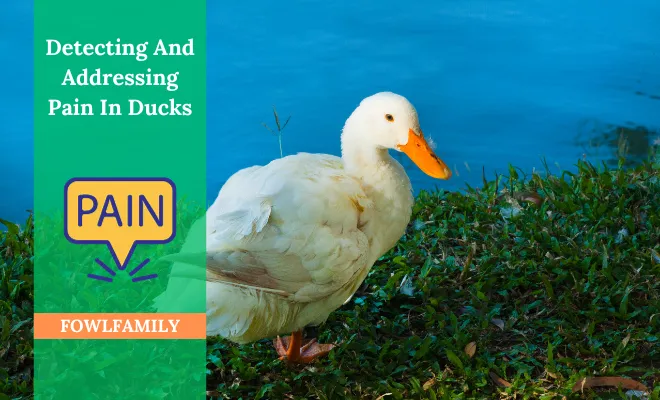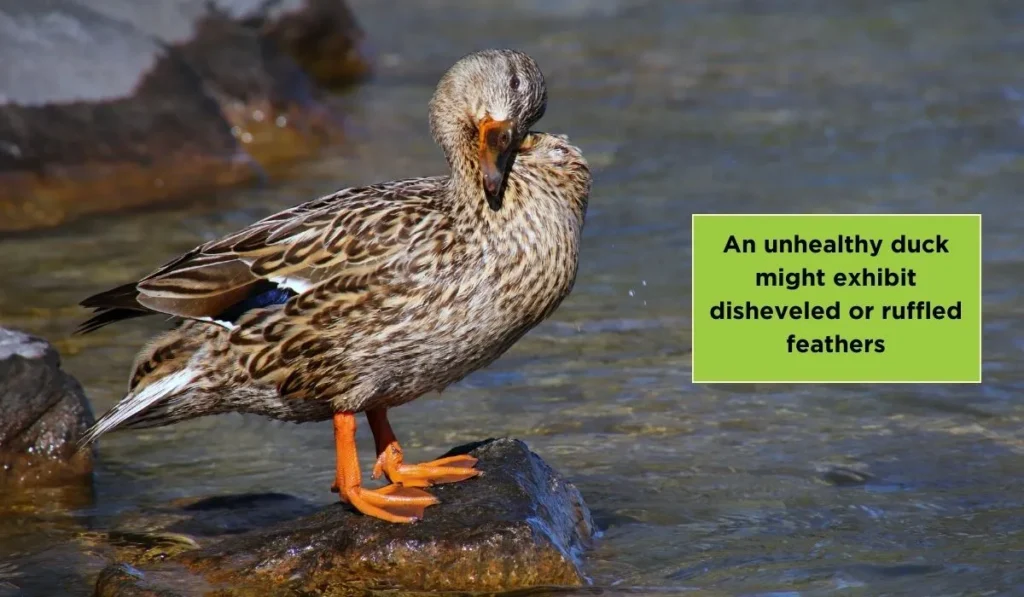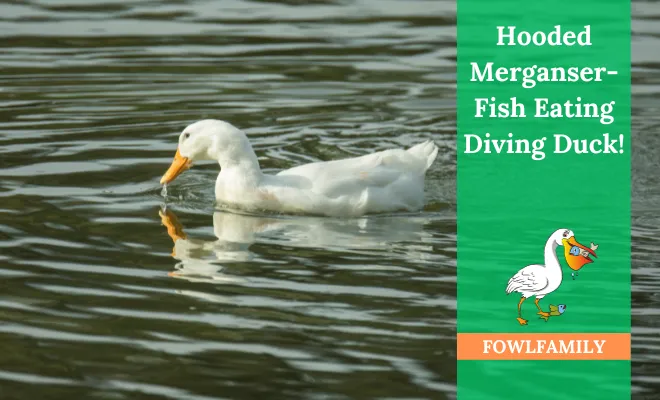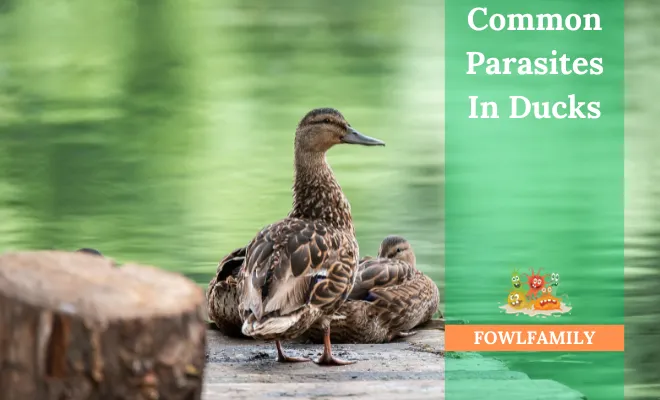How Do You Know If A Duck Is In Pain? Let’s Address the Pain in Ducks!

Ducks can’t express themselves like humans when they are in pain. So, how do you know if a duck is in pain? Identifying pain in ducks can be challenging. However, there are several signs to look for that may indicate a duck is in pain. These signs include
- Changes in behavior
- Vocalizations
- A hunched or tense posture
- Decreased appetite or drinking
- Limping and many more.
Additionally, a duck may show signs of distress through panting, increased heart rate, or difficulty breathing. Ducks can also be in pain because of diseases.
Here, I will tell you the signs and what you should do if your duck is in pain. Next time, your duck won’t have to be in pain as you’ll have the reasons and solutions.
Table of Contents
How Do You Know If A Duck Is In Pain? 12 Significant Signs

Ducks are very good at hiding their pain. So, it is important to be aware of the signs that they may be in distress.
Here is a video that shows a duck in pain:
Now, here are some signs that indicate a duck is in pain.
1. Altered Behavior
A prominent indicator that a duck might be experiencing discomfort is a change in its behavior. As inherently social creatures, ducks in pain often exhibit increased withdrawal and decreased activity. This can manifest as isolation from their group, diminished grooming, or even the display of aggression toward fellow ducks.
2. Vocalization

Ducks are not known for their loud quacking. But a sudden and continuous increase in quacking can be a sign of distress. The pitch and tone of their quacks may also change, becoming more high-pitched or frantic when they are in pain.
3. Lethargy
A duck in pain may become lethargic. They may appear less interested in swimming, foraging, or engaging in their usual activities. Lethargy can be a clear indicator that something is wrong.
4. Changes in Posture and Movement
When a duck is in pain, it may exhibit abnormal postures and movements. For example, it might hunch its body, walk with a limp, or have difficulty standing or sitting. These changes are often a response to physical discomfort.
5. Reduced Appetite
Pain can cause a duck to lose its appetite. If you notice a significant reduction in food intake, it could be a sign of pain. Ducks may also have difficulty swallowing or appear to be in discomfort when eating.
6. Abnormal Feathering

An unhealthy duck might exhibit disheveled or ruffled feathers. This can be a result of stress and discomfort in ducks. Ducks rely on their feathers for insulation and buoyancy, and when these are compromised, it can cause physical and emotional distress.
7. Weight Loss
Weight loss is a common consequence of pain and suffering in ducks. If you observe a duck losing a significant amount of weight or appearing thinner than usual, it’s a cause for concern.
8. Respiratory Distress
Respiratory issues, such as labored breathing, wheezing, or nasal discharge, can indicate pain or illness. Ducks with respiratory problems are often in discomfort and may require immediate attention.
Related Reading: Why Is My Duck Sneezing
9. Self-Mutilation
In some cases, ducks in pain may resort to self-mutilation. It can manifest as excessive feather plucking, pecking at their bodies, or even biting their own feet. Self-mutilation is a clear sign of emotional distress or physical discomfort.
10. Reduced Mobility

Ducks rely on their mobility for various activities, including escaping predators, foraging, and swimming. Pain can limit their ability to move freely. And you may notice them struggling to get in and out of the water, take flight, or walk.
11. Changes in Egg-Laying
If you have female ducks, a decrease in egg production or issues with laying eggs may indicate pain or health problems.
Egg-laying patterns in ducks can be significantly impacted by pain. When ducks experience discomfort from injuries, illnesses, or stress, it can lead to observable changes in their reproductive behavior.
These changes may include –
- Disruptions in hormonal balance
- Alterations in nesting behavior
- A decrease in both the quantity and quality of eggs
- Physical signs of discomfort such as limping or reluctance to move.
12. Affected by Diseases
Ducks can be in pain because of diseases like Botulism, Bumblefoot, Eye infections, Impacted crops, Salmonella, etc. Check the next section to have a clear understanding of the way diseases keep ducks in pain.
Botulism:
Botulism is a severe condition affecting ducks. It results from the toxic byproducts produced by the bacterium Clostridium botulinum. Ducks with botulism typically exhibit the following symptoms:
- Muscle weakness and paralysis initially affect their legs and wings.
- Noticeable drooping of the eyelids and neck.
- Challenges in both flying and swimming.
- Difficulty with eating and drinking.
- The presence of diarrhea.
Related Reading: Ducks Broken Leg Problem
Bumblefoot:
It is scientifically referred to as pododermatitis. It is a prevalent bacterial foot pad infection seen in poultry, including ducks. Ducks affected by bumblefoot typically experience the following:
- Limping or lameness.
- Swelling and a reddish appearance in the foot pad.
- Development of a dark scab or abscess on the foot pad.
- Pain and discomfort.
Eye Infection:
Eye infection is common in ducks. Here are the symptoms of it:
- The eye appears red and swollen and may discharge.
- Ducks squint or keep the affected eye closed.
- They rub the eye with their wing.
- Sensitivity to light is noticeable.
- A decrease in their overall vision.
Impacted Crops:
An impacted crop in ducks signifies a situation where the crop has a storage pocket in the esophagus for pre-digested food. It gets obstructed or enlarged. Signs of an impacted crop in ducks encompass:
- A crop that is noticeably swollen and firm.
- A notable lack of energy or enthusiasm.
- Reduced appetite or refusal to eat.
- Experiencing challenges when swallowing.
- Spontaneous regurgitation of food.
- A noticeable decline in body weight.
Salmonella:
Salmonella in ducks is a type of bacteria that can cause salmonellosis, a foodborne illness. Symptoms of this disease are:
- A pronounced lack of energy.
- Reduced or complete loss of interest in eating.
- Frequent bouts of diarrhea.
- Feces appearing greenish or tinged with blood.
- Instances of vomiting.
- Noticeable decline in body weight.
6 General Suggestions To Follow When Ducks Are In Pain

If you notice the signs mentioned above, this means your duck is in pain. Here is a guideline that you can do when your duck is in pain.
- Consult a Veterinarian: If you suspect that your duck is in pain, it is essential to consult a veterinarian with experience in avian medicine.
- Isolate the Affected Duck: To prevent further stress or harm to any other duck, isolate the affected duck from the flock in a warm and quiet environment. Ensure it has access to food, water, and clean bedding.
- Provide Supportive Care: Offer extra care and attention to the duck. Ensure it is eating and drinking, and administer any medications or treatments prescribed by the veterinarian.
- Address the Underlying Cause: Pain in ducks can result from various causes, including injuries, infections, or underlying health issues. Addressing the root cause is crucial for the duck’s recovery.
- Monitor Progress: Keep a close eye on your duck’s condition. Document any changes in behavior, appetite, or physical appearance, and report these observations to your veterinarian.
- Prevent Future Pain: To avoid recurrent pain in your ducks, make sure their living conditions are safe and comfortable. Protect them from predators, provide appropriate nutrition, and keep their environment clean and well-maintained.
Bottom Line
Ducks may not express their pain as overtly as humans do. But they show subtle signs that attentive duck keepers can watch for. Changes in behavior, vocalizations, altered posture and movement, and reduced appetite are among the key indicators.
If you notice these signs, it’s important to take action. Consulting a veterinarian experienced in avian medicine is the first step. Then, you can take some other steps like isolating the affected duck, providing supportive care, and closely monitoring their progress. Being attuned to these signs and taking appropriate action can help ensure the health and happiness of your feathered friends.
Resources & References:
- https://www.backyardchickens.com/threads/i-could-use-some-good-advice-how-do-i-know-if-my-duck-is-in-pain.1090081/
- https://www.caringpets.org/how-to-take-care-of-a-pet-duck/treat-health-issues/






